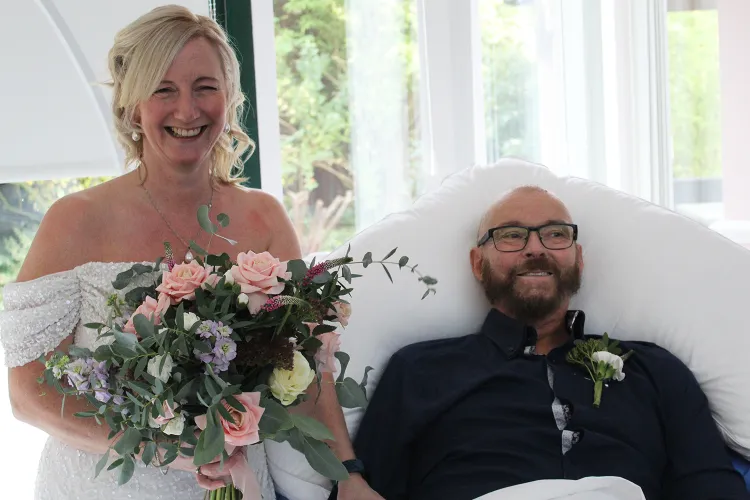Days Before Their First Anniversary, a Wisconsin Couple Was Found Dead on a Roadside — Now Police Say the Newlyweds’ Deaths Were a Heartbreaking Murder-Suicide
The photo shared by loved ones shows two smiling faces pressed close together, framed by a soft Midwestern sunset. Brandon and Rachel Dumovich look warm, relaxed, impossibly happy in that image — the kind of picture that tells a story of young love, shared dreams, and a future wide open with possibility. But behind that frozen moment lies a tragedy that has shaken two states, left friends and family searching for answers, and ended a marriage that hadn’t yet reached its first anniversary.

The Wisconsin newlyweds, found dead inside a vehicle on the shoulder of a rural Illinois road just days before their one-year wedding milestone, were the victims of a murder-suicide, law enforcement officials confirmed this week. The conclusion, based on physical evidence, autopsy results, and investigative review, has brought devastating clarity to a mystery that unfolded suddenly and left a trail of grief in its wake.
When authorities first discovered the couple’s vehicle, the scene raised immediate alarm. There had been no major crash, no extended chase, no severe weather. The car was pulled to the side in a way that suggested a deliberate stop, not an emergency. Both Brandon, 35, and Rachel, 32, were found inside, unresponsive. The initial call described the situation as a possible medical emergency. But by the time investigators finished their early assessments, the tone shifted quickly. Something was terribly wrong.

The Dumoviches, who lived in Wisconsin but were driving through northern Illinois at the time of their deaths, had built what those close to them described as a loving, hopeful life together. Married in 2023, they had recently moved into a new place, talked openly about future plans, and often posted pictures of themselves hiking, traveling, and spending time with friends. Rachel’s social media pages were filled with snapshots of lake days, birthday celebrations, and quiet moments at home. Brandon’s accounts showed a man who loved being outdoors, appreciated humor, and adored his wife.
To the people who knew them, their relationship looked strong, affectionate, and steady. That is what has made the news so difficult to absorb for friends, neighbors, and relatives still trying to reconcile the images they knew with the investigation’s findings.

Officials have kept certain details private out of respect for the families, but they confirmed that the evidence points clearly to Brandon taking Rachel’s life before taking his own. Police emphasized that there was no sign of outside involvement, no indication of another vehicle or person at the scene, and no evidence suggesting robbery or random violence. The outcome, as horrific as it is, appears to have been contained entirely within the confines of the couple’s car.
For many, that reality is the hardest part.
Rachel’s friends describe her as “the kind of person everyone loved instantly” — warm, patient, funny, and grounded. She was known for making people feel at ease, for sending long check-in messages, and for being the friend who remembered birthdays, anniversaries, and the small victories most overlook. She worked in a field that allowed her to connect with people every day, and colleagues say she brought a rare lightness to even the toughest workdays.
Those close to Brandon say he was charismatic, loyal, and passionate about the outdoors. They recall fishing trips, weekend bonfires, and the way he talked about finding real happiness when he met Rachel. Many of their loved ones watched the two fall for each other gradually — a friendship that deepened into something stronger and eventually became a marriage built on shared values, laughter, and mutual admiration.

But as investigators reviewed toxicology reports, digital evidence, and communication logs, they began piecing together a fuller picture — one that includes signs of strain that had not been publicly visible. Officials have not disclosed the private elements of the couple’s relationship that may have contributed to the events, but they confirmed there had been no active restraining orders or publicly documented history of domestic disturbances. Still, detectives emphasize that many relationships experience struggles unseen by friends or family, and tragedies like this often have warning signs that never surface until it is too late.
Domestic violence specialists, speaking generally and not about this specific case, note that murder-suicides in intimate relationships often occur after escalating emotional turmoil, possessiveness, or a sudden triggering event. They stress that outward appearances can be deceiving — even couples who seem outwardly happy may be grappling with internal conflict no one else knows about.
What has emerged most clearly from voices surrounding this case is the profound grief of two families who never imagined a loss like this. Loved ones from both sides have described themselves as “shattered,” “confused,” and “broken open” by what happened. Parents who were preparing to celebrate their children’s first anniversary are now planning memorials instead. Friends who expected to see Rachel posting anniversary photos are instead sharing tributes filled with disbelief.
The repercussions have stretched beyond the couple’s immediate circles. The small Wisconsin community where they lived has come together in vigils, prayer gatherings, and support groups. Local counselors have volunteered free sessions for those affected. Domestic-violence organizations have shared resources in hopes of raising awareness about the warning signs that many do not recognize until it is tragically late.
The shock has extended into Illinois as well, particularly among first responders who arrived at the roadside scene. As one official put it privately, “These are the cases that stay with you. You always hope to find something different than what the evidence is telling you. But sometimes the truth is exactly what you don’t want it to be.”
Yet the focus from many who knew the couple has been on honoring their lives, not on the circumstances of their deaths. Rachel is remembered as a joyful presence, the type of person who made others feel seen and valued. Brandon is remembered as someone who loved deeply, laughed loudly, and found comfort in the natural world. Friends have been sharing the moments that made them who they were: the way Rachel always showed up early to help set up for gatherings, the way Brandon would bring extra gear on hikes for anyone who forgot something, the way they both loved sunsets, road trips, and quiet weekends at home.
Their final photo together — smiling, leaning close, framed by fading daylight — has become both a source of heartbreak and a reminder of how they lived, not just how they died. That image now circulates not as a symbol of tragedy but as a testament to a couple whose lives touched many, whose story matters, and whose memories deserve care, dignity, and truth.
The investigation is formally closed, but the emotional processing has only just begun for those left behind. Friends say they are focusing on supporting each other, checking in regularly, and ensuring that their community does not let the weight of this tragedy fall silently. Discussions about mental health, relationship stress, and early warning signs are already happening — not in a way that assigns blame, but in a way that promotes understanding, awareness, and healing.
As one family friend put it simply, “We lost two people we loved. That’s what we’re trying to hold on to — who they were before any of this.”
In the end, the story of Brandon and Rachel Dumovich is not defined solely by its heartbreaking conclusion. It is also a story of love found, lives intertwined, and the deep imprint two people can leave on their world. Their families hope that as details continue to circulate publicly, the focus remains on empathy, compassion, and the importance of checking on those who may be struggling silently.
They hope people remember the laughter captured in their photos, the warm stories shared at gatherings, the kind gestures, and the love that was real — even in the midst of heartbreak. They hope people hold onto the idea that every life holds complexity, and every loss carries a lesson about care, community, and connection.
For now, two families grieve the unimaginable, a community mourns alongside them, and loved ones cling to the memories that feel both comforting and unbearably painful. Brandon and Rachel are gone, but their story — one of joy, sorrow, love, and loss — remains, urging those who knew them to hold tighter to the people they love and to look for the signs that someone might need more help than they are letting on.



